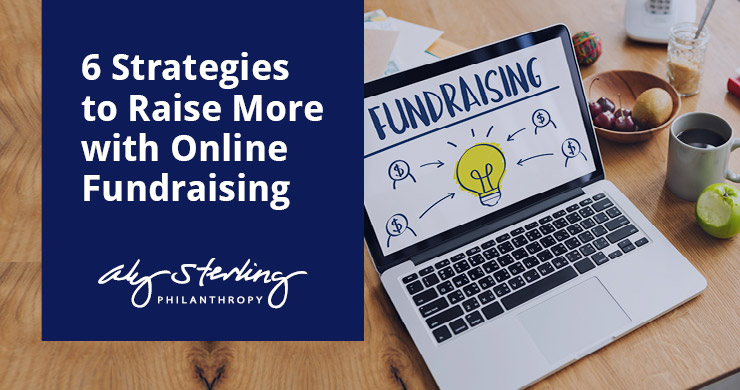
Online fundraising is a solid strategy in boosting donor engagement and helping organizations reach their goals. In fact, the 2022 Giving USA Report showed that online giving made up 12% of total giving in 2021 and is expected to increase with the continued rise of social giving.
Online fundraising can take many forms, from promoting peer-to-peer fundraisers on Facebook to directing supporters on your website to your annual giving page. By taking the donation process to the web, your organization can effectively expand its reach and encourage supporters to fundraise on your behalf with their own innovative campaigns.
However, without a strong plan in place for grabbing supporters’ attention, it can be difficult to effectively engage donors online and help them connect with your cause. Use this guide to make online fundraising a central component of your fundraising plan:
- Optimize your donation forms
- Tap into peer-to-peer fundraising
- Leverage Google Ads
- Host online auctions
- Sell nonprofit merchandise
- Hire a fundraising consultant
To manage your online fundraisers with ease, you’ll need the right tools. A robust online fundraising software solution can help your organization customize campaigns, increase donor engagement with gamification and social fundraising, and generate real-time analytics to assess campaign performance. Equipped with a strong technology foundation, your nonprofit will be in great shape to carry out the following best practices. Let’s dig in!
1. Optimized Donation Forms
When launching an online fundraising campaign, make sure your donation page is fully optimized and easy to navigate. If your form is too long or visually unappealing, supporters will be more likely to click away, causing your organization to miss out on key support.
Aside from being professional in appearance, your donation form should be:
- Customizable. Customize donation levels and highlight the impact of specific giving amounts. For example, an animal welfare organization might explain that a donation of $25 can feed 10 cats for a month. You’ll also want to add in custom form questions to ensure you capture the information you need.
- Simple but comprehensive. Don’t ask for too much information on the form, otherwise this may deter donors from completing their gift. Stick to the most essential information, such as donors’ contact information, billing information, and donation amount. You can always collect more information as you build relationships with your donors.
- Branded to your organization. Embed your form into your website and keep it consistent with your organization’s branding to instill trust in your donors. When donors land on your donation page, they’ll feel confident that they’re giving to your organization.
- Accessible. Your donation form should follow accessibility best practices so that it is inclusive to all users. Make sure all form fields have descriptions outside of the text boxes so that they can be read by screen readers. Also, ensure any images have alternative text and use strong color contrast to make the form easier to read.
- Mobile-optimized. Your form should be easily viewable from a mobile device so users can submit a donation anywhere, at any time, as long as they have a phone in hand. In fact, Double the Donation reported that the number of transactions completed through mobile devices increased by 50% last year, demonstrating the importance of creating a positive mobile donation experience. If donors need to zoom in or out or rotate their screens repeatedly to view your page, they’ll likely abandon it altogether.
By making the donation experience as convenient and user-friendly as possible, your supporters will be more likely to visit your form and see their donations through to completion.
2. Peer-to-Peer Fundraising
Peer-to-peer fundraising is a powerful social giving method and a great tool to add to your online fundraising toolkit. Instead of having to fully manage and run fundraising campaigns on your own, your organization can recruit supporters to fundraise on your behalf, amplifying your reach and helping you engage new networks. Plus, this can help you strengthen relationships with your fundraising volunteers.
Here’s how peer-to-peer fundraising works:
- The nonprofit selects its peer-to-peer fundraising platform and decides on a goal.
- The nonprofit sets up its peer-to-peer fundraising campaign page and recruits participants to fundraise on their behalf.
- The participants undergo training and set up their own campaign pages.
- The participants share their individual campaign pages with their friends and family.
- The nonprofit monitors ongoing progress and provides support as needed.
According to the OneCause guide to peer-to-peer fundraising, your nonprofit can also tap into ambassador fundraising to amplify your cause among even more people. Ambassadors are well-connected individuals who can repost content advertising your peer-to-peer fundraiser on their social media pages and even lead their own campaigns. Consider asking influential board members, volunteers, donors, or corporate connections to lead an ambassador campaign.
3. Google Ads
If you’re looking for an online fundraising and marketing channel with a broad reach, it doesn’t get much better than Google Ads. Google is the world’s most visited website, fielding 8.5 billion searches per day.
Google Ads are sponsored search ads that appear at the top of the page for certain keywords. For example, these are the ads that appear on the search results page for the keyword “conservation organizations”:

Nonprofits are eligible to apply for the Google Ad Grant, which provides qualifying organizations with $10,000 per month in free advertising credits. This can help you reduce your cost per dollar raised when it comes to fundraising on this channel.
To maximize your fundraising potential with Google Ads, it isn’t enough just to apply for the grant program, set a few keyword targets and call it a day. Prioritize optimizing your Google Ad Grant strategy in the following ways:
- Choose the right keywords for your ad campaign. Your keyword targets should be relevant to your nonprofit’s work or fundraising initiatives. For example, a nonprofit focused on increasing signups for a fundraising 5K might target the keywords “local 5Ks near me” or “charity 5K races in [your city’s name].”
- Link to useful pages in your Google Ads. Your ads should lead visitors to useful pages on your website where they can take actions that increase their involvement in your work. For example, you may use your ads to direct traffic to your online donation page, peer-to-peer fundraising signup form, or email newsletter.
- Track relevant metrics to measure your progress. Using data to assess the success of your Google Ad strategy will help you identify what’s working and what could be improved. Plus, Google requires you to track metrics such as your conversion and click-through rates to ensure that you’re using the funding effectively.
Whether you’re using Google Ads to promote your fundraising campaigns, online donation page, or newsletter signup form, these marketing tools are an effective way to introduce your mission to an audience that has already expressed interest in your cause. Google Ads can supplement your organic SEO strategy, ensuring that more of your nonprofit’s content is highly visible on search results pages.
4. Online Auctions
Online auctions are essentially digital silent auctions. There are many benefits to hosting an online charity auction, including expanding your reach, driving donor engagement, and raising a significant amount of funds. Since these auctions are completely online, they’re more cost-effective and can be opened up to more supporters, increasing your fundraising potential.
Here’s how you can get started with an online auction:
- Set your goal and budget.
- Partner with an auction software platform that will make managing every step of your event a breeze.
- Recruit an auction team for procurement, promotion, and setting up your item catalog.
- Market your event widely to boost the number of registrants.
Before your event, consider sending a sneak peek of your item catalog to create hype for your event. Be sure the photos are high-quality, since bidders can’t view the items in person, and offer a detailed description of each item. The more effort you put into showcasing your items, the more you’ll raise.
Online auctions offer a great way to fundraise without adding too much cost for your organization. You can also reach out to local businesses and see if they would be willing to fund or provide auction items in exchange for free marketing at your event.
5. Merchandise
To further motivate donors to give to your cause, consider selling merchandise. In exchange for their donations, supporters will get a t-shirt, hat, or other branded merchandise, making it a win-win situation!
The benefits of selling merchandise online are two-fold:
- You can raise more revenue from offering this added incentive.
- You can spread more awareness around your cause and your nonprofit when people walk around wearing your merch.
Work with a t-shirt fundraising platform so you can build a customized web page to sell your products and manage sales all in one place. Plus, the right platform should allow you to design and sell merchandise the way you want to, empowering you to come up with a number of innovative and fun branded designs that accurately represent your organization. Alternatively, if you don’t have design experience, your platform should offer templated designs you can easily adjust to reflect your brand.
6. Consultants
Sometimes, even with your online fundraising strategy in the works, you may need some outside help. This is where hiring a consultant comes into play. A nonprofit consultant with extensive fundraising experience can help your organization identify gaps in its existing approach to online fundraising and formulate a plan of action tailored to your nonprofit.
There are a few things to keep in mind when hiring a fundraising consultant, such as:
- Your nonprofit’s needs and goals. Are you ready to hire a nonprofit consultant? How will this benefit your online fundraising needs? Do you need more strategic or technical support?
- The services fundraising consulting firms offer. A consultant can help you build strong donor relationships and raise more money through fundraising assessments, feasibility studies, and more.
- Referrals from your network. Ask your respected peers and other community-based organizations that can offer your nonprofit a list of fundraising consultants to choose from.
- Your own research. Be sure to perform your own research online to ensure you understand each consultant’s founding philosophies, location, specialty areas, etc.
The right fundraising consultant can help you lead more successful online fundraisers. Plus, a fundraising consultant with experience in strategic planning and board leadership can help your nonprofit improve its internal operations and optimize your team’s efficiency to achieve your goals.
Online fundraising can deliver promising fundraising results for your organization, but only if you have a concrete plan. Make sure to consider your audience, form clear goals, and outline ways that you’ll measure success to make sure you’re on track. Happy fundraising!
Author Bio

Kelly Velasquez-Hague brings over 20 years of fundraising, nonprofit management, and sales/marketing experience to her role as the Director of Content Marketing for OneCause. As a member of the OneCause sales and marketing team, Kelly manages all of the company’s content strategy and execution. She is passionate about empowering great missions and loves that her current role allows her to continue to help nonprofits reach new donors raise more funds for their cause.